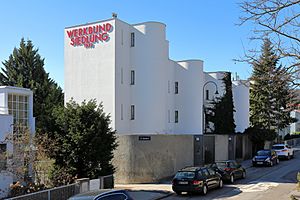André Lurçat facts for kids
André Lurçat (born August 27, 1894 – died July 11, 1970) was a famous French architect. He was a modernist, meaning he liked new and simple designs. He also designed landscapes, furniture, and helped plan cities. André Lurçat was a founding member of an important group called the CIAM. After World War II, he played a big role in rebuilding French cities. His brother, Jean Lurçat, was also a well-known artist.
Contents
Who Was André Lurçat?
André Lurçat was born in Bruyères, France. He studied art and architecture at the École des Beaux-Arts in Nancy. Early in his career, he worked for another famous architect, Robert Mallet-Stevens. In the 1920s, Lurçat started designing many houses. He became very interested in social housing. This means building affordable homes for many people. He wanted to help solve the housing problems in France between the two World Wars.
Joining Modern Architecture Movements
In 1928, André Lurçat helped start the Congrès International d'Architecture Moderne (CIAM). This group brought together architects who wanted to create modern buildings. In 1932, he showed a family home design at an exhibition in Vienna. He worked with other famous architects like Adolf Loos and Richard Neutra. One of his most famous houses, the Hefferlin villa, was built in Ville-d'Avray. From 1934 to 1937, he even worked for the government in Moscow.
André Lurçat's Big Ideas
André Lurçat was a leader in bringing modern ideas to landscape design. He believed that all social housing should have gardens. This was different from some others who thought homes should be as small as possible. He argued that gardens were important for people's well-being.
Rebuilding Cities and Teaching
After World War II, André Lurçat helped plan the rebuilding of the French city of Maubeuge in 1945. He also taught architecture in Paris. He was a professor at the École nationale supérieure des Arts Décoratifs and the École nationale supérieure des Beaux-Arts from 1945 to 1947. He also served on the architecture board for the Ministry of Reconstruction and Urban Development. This shows how important his ideas were for rebuilding France.
Selected Buildings
- Villa Guggenbuhl (1927), Rue Nansouty, Paris 48°49′24″N 2°20′07″E / 48.823325°N 2.335326°E
Selected Writings
- Architecture, Paris: Au Sans Pareil, 1929.
- Formes, composition et lois d'harmonie: Eléments d'une science de l'esthétique architecturale, Paris, Editions Vincent, Fréal & Cie, 1953.
- Œuvres récentes, Paris, Editions Vincent, Fréal & Cie, 1961.
See also
 In Spanish: André Lurçat para niños
In Spanish: André Lurçat para niños


